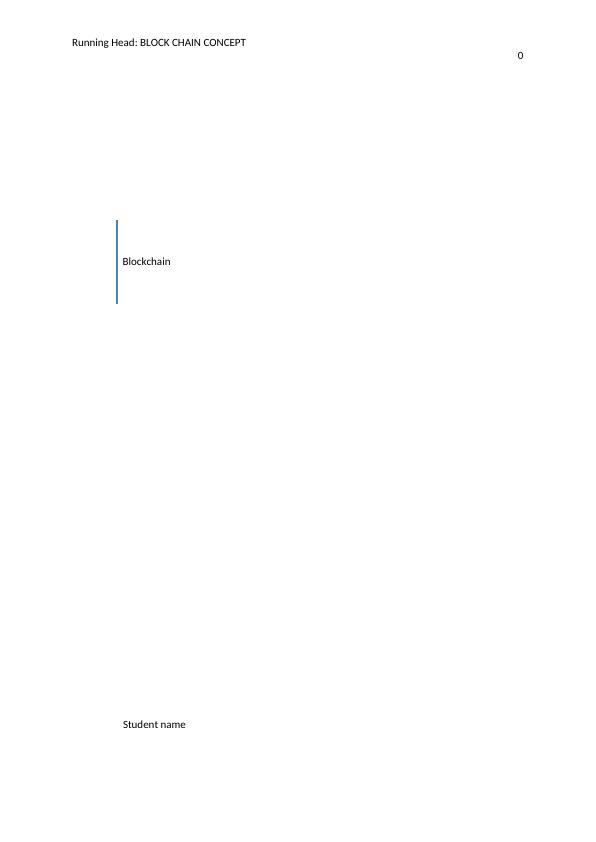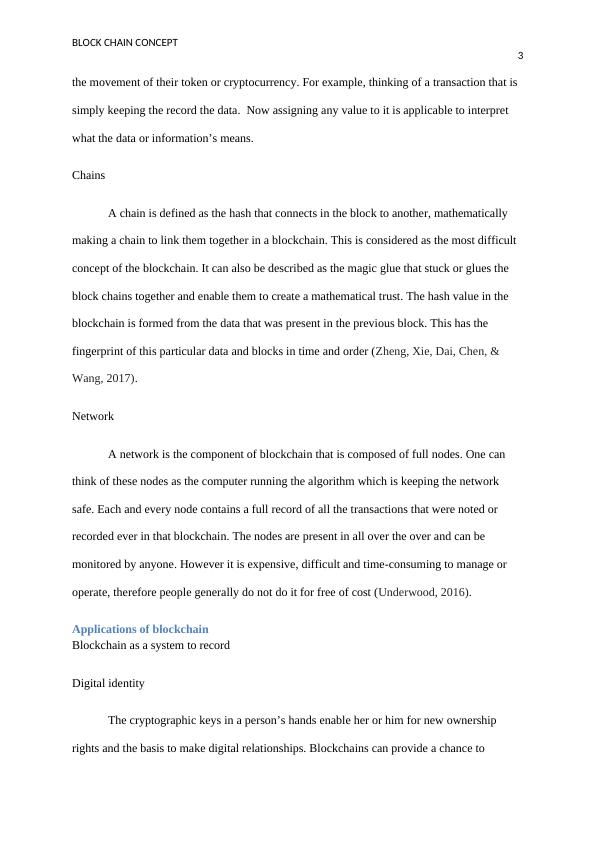Blockchain: A Distributed Ledger for Transactional Data
Added on 2023-06-03
12 Pages3000 Words133 Views
Running Head: BLOCK CHAIN CONCEPT
0
Blockchain
Student name
0
Blockchain
Student name

BLOCK CHAIN CONCEPT
1
Table of Contents
Introduction................................................................................................................................2
Structure of block chains........................................................................................................2
Applications of blockchain.....................................................................................................3
The life cycle of blockchains..................................................................................................5
Pros and cons of blockchain...................................................................................................6
Blockchain technology in UAE..............................................................................................7
Regulation of blockchain around the world...........................................................................7
Effects of blockchain on the economy and business..............................................................8
Legal issues involved.............................................................................................................8
Conclusion..................................................................................................................................9
References................................................................................................................................10
1
Table of Contents
Introduction................................................................................................................................2
Structure of block chains........................................................................................................2
Applications of blockchain.....................................................................................................3
The life cycle of blockchains..................................................................................................5
Pros and cons of blockchain...................................................................................................6
Blockchain technology in UAE..............................................................................................7
Regulation of blockchain around the world...........................................................................7
Effects of blockchain on the economy and business..............................................................8
Legal issues involved.............................................................................................................8
Conclusion..................................................................................................................................9
References................................................................................................................................10

BLOCK CHAIN CONCEPT
2
Introduction
The blockchain is a kind of distributed ledger used to maintain a permanent and the
temporary proof record of transactional information. A blockchain works as a decentralized
database which is managed by the computer belonging to P-2-P (peer to peer) network. Every
computer in the distributed network monitor or maintain a clone of a ledger to stop one point
of failure and entire copies are validated and updated simultaneously. Previously the block
chains were generally associated with bitcoin, and digital currencies specifically (Pilkington,
2016). Nowadays block chain used by many industries as a safe and cost-effective way in
order to generate and maintain a distributed database and to manage the records for the online
transactions of different types (Crosby, Pattanayak, Verma, & Kalyanaraman, 2016). The
very first work on the cryptographically secured chains of the blocks was explained in 1991
by two-person named Stuart Haber and W. Scott Stornetta. The first block chain has been
conceptualized in 2008 by Satoshi Nakomoto (Crosby, Pattanayak, Verma, & Kalyanaraman,
2016). In this particular report, the topics like the pros and cons of the blockchain, regulation
of this technology in UAE and in the world will be discussed. Its impact on the economy and
business and the legal issues and essential documentation involved in this will also be
mentioned in this report.
Structure of block chains
The structure of blockchain consist of the main three components
Blocks
A block is the list of the transactions noted into a ledger over a specific time period.
For every blockchain the size, period and triggering events of the blocks are different. All the
block chains are not recording and securing the records of the transportation or movements of
their cryptocurrency as their first objective. However, all the bock chains do note or record
2
Introduction
The blockchain is a kind of distributed ledger used to maintain a permanent and the
temporary proof record of transactional information. A blockchain works as a decentralized
database which is managed by the computer belonging to P-2-P (peer to peer) network. Every
computer in the distributed network monitor or maintain a clone of a ledger to stop one point
of failure and entire copies are validated and updated simultaneously. Previously the block
chains were generally associated with bitcoin, and digital currencies specifically (Pilkington,
2016). Nowadays block chain used by many industries as a safe and cost-effective way in
order to generate and maintain a distributed database and to manage the records for the online
transactions of different types (Crosby, Pattanayak, Verma, & Kalyanaraman, 2016). The
very first work on the cryptographically secured chains of the blocks was explained in 1991
by two-person named Stuart Haber and W. Scott Stornetta. The first block chain has been
conceptualized in 2008 by Satoshi Nakomoto (Crosby, Pattanayak, Verma, & Kalyanaraman,
2016). In this particular report, the topics like the pros and cons of the blockchain, regulation
of this technology in UAE and in the world will be discussed. Its impact on the economy and
business and the legal issues and essential documentation involved in this will also be
mentioned in this report.
Structure of block chains
The structure of blockchain consist of the main three components
Blocks
A block is the list of the transactions noted into a ledger over a specific time period.
For every blockchain the size, period and triggering events of the blocks are different. All the
block chains are not recording and securing the records of the transportation or movements of
their cryptocurrency as their first objective. However, all the bock chains do note or record

BLOCK CHAIN CONCEPT
3
the movement of their token or cryptocurrency. For example, thinking of a transaction that is
simply keeping the record the data. Now assigning any value to it is applicable to interpret
what the data or information’s means.
Chains
A chain is defined as the hash that connects in the block to another, mathematically
making a chain to link them together in a blockchain. This is considered as the most difficult
concept of the blockchain. It can also be described as the magic glue that stuck or glues the
block chains together and enable them to create a mathematical trust. The hash value in the
blockchain is formed from the data that was present in the previous block. This has the
fingerprint of this particular data and blocks in time and order (Zheng, Xie, Dai, Chen, &
Wang, 2017).
Network
A network is the component of blockchain that is composed of full nodes. One can
think of these nodes as the computer running the algorithm which is keeping the network
safe. Each and every node contains a full record of all the transactions that were noted or
recorded ever in that blockchain. The nodes are present in all over the over and can be
monitored by anyone. However it is expensive, difficult and time-consuming to manage or
operate, therefore people generally do not do it for free of cost (Underwood, 2016).
Applications of blockchain
Blockchain as a system to record
Digital identity
The cryptographic keys in a person’s hands enable her or him for new ownership
rights and the basis to make digital relationships. Blockchains can provide a chance to
3
the movement of their token or cryptocurrency. For example, thinking of a transaction that is
simply keeping the record the data. Now assigning any value to it is applicable to interpret
what the data or information’s means.
Chains
A chain is defined as the hash that connects in the block to another, mathematically
making a chain to link them together in a blockchain. This is considered as the most difficult
concept of the blockchain. It can also be described as the magic glue that stuck or glues the
block chains together and enable them to create a mathematical trust. The hash value in the
blockchain is formed from the data that was present in the previous block. This has the
fingerprint of this particular data and blocks in time and order (Zheng, Xie, Dai, Chen, &
Wang, 2017).
Network
A network is the component of blockchain that is composed of full nodes. One can
think of these nodes as the computer running the algorithm which is keeping the network
safe. Each and every node contains a full record of all the transactions that were noted or
recorded ever in that blockchain. The nodes are present in all over the over and can be
monitored by anyone. However it is expensive, difficult and time-consuming to manage or
operate, therefore people generally do not do it for free of cost (Underwood, 2016).
Applications of blockchain
Blockchain as a system to record
Digital identity
The cryptographic keys in a person’s hands enable her or him for new ownership
rights and the basis to make digital relationships. Blockchains can provide a chance to

End of preview
Want to access all the pages? Upload your documents or become a member.
Related Documents
Block Chain Technologylg...
|8
|365
|13
Block Chain Security Article 2022lg...
|11
|2780
|11
Applications of Block Chain Assignment 2022lg...
|13
|324
|15
Assignment on Everything About Blockchain Technologylg...
|11
|3476
|20
The Potential of Adopting Blockchain Technology and Developing Smart Construction Contractslg...
|21
|6114
|370
Blockchain Technology and Its Impact on Auditing Practicelg...
|9
|2566
|185